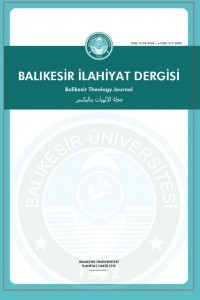Batıl İnançları Ölçmek: Şanslı Takılar Neden Önemsenir?
Batıl inançların kaynağı ve işlevi hakkında bu inançların psikolojik temelleri bazında teori geliştirmeye yönelik hatırı sayılır miktarda araştırma yapılmıştır. Bu çalışmaların çoğunda batıl inançlar Paranormal İnanç Ölçeği (PBS) ile ölçülmüştür. Ancak bu ölçek yalnızca olumsuz batıl inançlarla ilgili olup (örn: ayna kırmak kötü şans getirir), olumlu batıl inançlarını (örn: şanslı bir takı taşımak iyi şans getirir) atlamıştır. Burada bahsedilen iki çalışmada, olumlu ve olumsuz batıl inançlar ile birçok bireysel farklılık ölçekleri arasında anlamlı ilişki bulunmuştur. Bu bulgular, Paranormal İnanç Ölçeği’nin batıl inançların ölçümü için yeterli olmadığını ve olumlu batıl inançlarla ilgili maddeleri de içeren yeni ölçeklere ihtiyaç olduğunu ortaya koymakta ve böylece teori gelişimi için önemli sonuçlar içermektedir.
Anahtar Kelimeler:
Batıl inanç, Paranormal inanç, Paranormal inanç ölçeği, Olumlu batıl inanç, Olumsuz batıl inanç
___
- Alcock, J. E. Parapsychology: Science or magic? A psychological perspective. Elmsford: Pergamon Press, 1981.
- Brown, T. A., Chorpita, B. F., & Barlow, D. H.. Structural relationships among dimensions of the anxiety and mood disorders and dimensions of negative affect, positive affect, and autonomic arousal. Journal of Abnormal Psychology, 1998, 107, 179–192.
- Chorpita, B. F., & Barlow, D. H. (1998). The development of anxiety: The role of control in the early environment, Psychological Bulletin, 124, 3–21.
- Dag, I. (1999). The relationships among paranormal beliefs, locus of control and psychopathology in a Turkish college sample. Personality and Individual Differences, 26, 723–737.
- Diener, E., Emmons, R. A., Larson, R. J., & Griffin, S. (1985). The satisfaction with life scale. Journal of Personality Assessment, 49, 71–75.
- Eysenck, H. J., & Eysenck, S. B. G. (1991). Manual of the eysenck personality scales (EPS adult). London: Hodder &Stoughton.
- Frazer, J. G. (1922). The golden bough. London: Macmillan.
- French, C. C., & Kerman, M. K. (1996). Childhood trauma, fantasy proneness and belief in the paranormal. Paper presented at the Annual Conference of the British Psychological Society, London.
- Goulding, A., & Parker, A. (2001). Finding psi in the paranormal: Psychometric measures used in research in paranormal beliefs/experiences and in research on psi-ability. European Journal of Parapsychology, 16, 73–101.
- Hergovich, A. (2003). Field dependence, suggestibility and belief in paranormal phenomena. Personality and Individual Differences, 34, 195–209.
- Hewson, C. (2003). Conducting research on the Internet. The Psychologist, 16, 290–293.
- Irwin, H. J. (1992). Origins and functions of paranormal belief: The role of childhood trauma and interpersonal control. Journal of the American Society for Psychical Research, 86, 199– 208.
- Irwin, H. J. (2000). Belief in the paranormal and a sense of control over life. European Journal of Parapsychology, 15, 68–78.
- Irwin, H. J. (in press). The psychology of paranormal belief. Parapsychological Monographs No. 20. New York: Parapsychology Foundation.
- Jahoda, G. (1969). The psychology of superstition. Harmondsworth: Penguin.
- Lange, R., Irwin, H. J., & Houran, J. (2000). Top-down purification of Tobacyk’s revised
- Paranormal Belief Scale Personality and Individual Differences, 29, 131–156. Lawrence, T. R. (1995). How many factors of paranormal belief are there? A critique of the
- Paranormal Belief Scale. Journal of Parapsychology, 59, 3–25.
- Journal of Balikesir University Faculty of Theology / ISSN: 2149-9969 Volume: 1 - Number: 1, June 2015
- Lawrence, T., Edwards, C., Barraclough, N., Church, S., & Hetherington, F. (1995). Modelling childhood causes of paranormal beliefs and experiences: Childhood trauma and childhood fantasy. Personality and Individual Differences, 19, 209–215.
- Malinowski, B. (1948). Magic, science and religion. Garden City: Doubleday.
- Newport, F., & Strausberg, M. (2001). Americans’ belief in psychic and paranormal phenomena is up over last decade. Princeton: Gallup News Service.
- Roig, M., Bridges, K. R., Renner, C. H., & Jackson, C. R. (1998). Belief in the paranormal and its association with irrational thinking controlled for context effects. Personality and Individual Differences, 24, 229–236.
- Ross, C. A., & Joshi, S. (1992). Paranormal experiences in the general population. Journal of Nervous and Mental Disease, 180, 357–361.
- Schmidt, W. C. (1997). World Wide Web survey research: Benefits, potential problems and solutions. Behaviour Research Methods, Instruments and Computers, 29, 270–273.
- Taylor, S. E. (1989). Positive illusions: Creative self-deception and the healthy mind. New York: Basic Books.
- Thalbourne, M. A., Dunbar, K. A., & Delin, P. S. (1995). An investigation into correlates of belief in the paranormal. Journal of the American Society for Psychical Research, 89, 215–231.
- Tills, H. cited in Haining, P. (1990). Superstitions. London: Treasure Press.
- Tobacyk, J. (1988). A revised paranormal belief scale. Unpublished manuscript, Louisiana Tech University, Rushton, LA.
- Tobacyk, J., & Milford, G. (1983). Belief in paranormal phenomena: Assessment instrument development and implications for personality functioning. Journal of Personality and Social Psychology, 44, 1029–1037.
- Tobacyk, J., Nagot, E., & Miller, M. (1988). Paranormal beliefs and locus of control: A multidimensional examination. Journal of Personality Assessment, 52, 241–246.
- Tobacyk, J., & Shrader, D. (1991). Superstition and self-efficacy. Psychological Reports, 68, 1387– 1388.
- Tobacyk, J., & Thomas, A. (1997). How the big orthogonal seven is really the oblique seven. Journal of Parapsychology, 61, 337–342.
- Tobacyk, J., & Wilkinson, L. V. (1990). Magical thinking and paranormal beliefs. Journal of Social Behavior and Personality, 5, 255–264.
- Vyse, S. A. (1997). Believing in magic: The psychology of superstition. New York: Oxford University Press.
- Wolfradt, U. (1997). Dissociative experiences, trait anxiety and paranormal beliefs. Personality and Individual Differences, 23, 15–19.
- ISSN: 2149-9969
- Yayın Aralığı: Yılda 2 Sayı
- Başlangıç: 2015
- Yayıncı: Balıkesir Üniversitesi
Sayıdaki Diğer Makaleler
İmam Mâtürîdî Teolojisinden Semantik Analizler: ‘Din & Şeriat & Hak Din & İslâm’ Kavramları Örneği
Matthew S. GORDON, Çevirmen: Mustafa KARA
İmam Cafer es-Sâdık’ın Siyasete ve Ehl-i Beyt’in İsyan Hareketlerine Karşı Tutumu
Batıl İnançları Ölçmek: Şanslı Takılar Neden Önemsenir?
Richard WİSEMAN, Caroline WATT, Çevirmen: Ayşe Burcu GÖREN
Osmanlıca Metinlerde İslâm Hukuku Motifleri: “Fetâvâ-Yı Birgivî” Örneği
